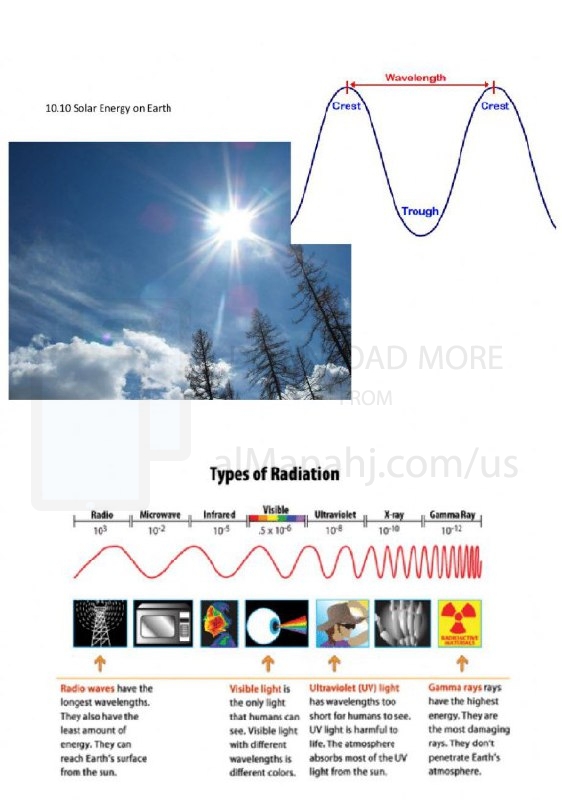| You are here: Almanahj Website ⇒ American curriculum ⇒ 6th Grade ⇒ Geology ⇒ Term 1 | ||
|---|---|---|
Worksheet about Solar Energy on Earth | ||
|---|---|---|
| Subject: Geology | ||
| 6th Grade | ||
| Term 1 | ||
| Year: 2023/2024 | ||
| Size: 254.8KB | ||
| Number of clicks: 139 | ||
| Publish date:November 29, 2023 | ||
| Added by: Eman | ||
| Last download date: 2024-09-02 01:19:18 | By: theodor Grace Vogt | |
| File info: Solar energy on Earth refers to the energy derived from the Sun's radiation that is harnessed and utilized for various purposes. The Sun is an abundant and renewable source of energy that provides a wide range of benefits. Here are some key points about solar energy on Earth: 1. Solar Power Generation: Solar energy can be converted into electricity through photovoltaic (PV) technology. Solar panels or solar cells made of semiconductor materials, such as silicon, capture sunlight and generate direct current (DC) electricity. This DC electricity is then converted into alternating current (AC) through inverters for use in homes, businesses, and utilities. Large-scale solar power plants can generate significant amounts of electricity. 2. Solar Thermal Systems: Solar energy can also be used for heating purposes through solar thermal systems. These systems utilize the Sun's heat to warm air or water. Solar water heaters, for example, use sunlight to heat water for domestic use or space heating. Concentrated solar power (CSP) technology uses mirrors or lenses to concentrate sunlight onto a receiver, which converts it into heat to produce steam and drive turbines for electricity generation. 3. Benefits of Solar Energy: Solar energy offers several advantages: a. Renewable and Abundant: The Sun is an inexhaustible energy source, ensuring long-term availability. b. Environmentally Friendly: Solar energy is clean and emits significantly fewer greenhouse gases compared to fossil fuel-based energy sources, contributing to reduced air pollution and combating climate change. c. Distributed Generation: Solar power can be generated close to the point of use, reducing transmission and distribution losses in the electrical grid. d. Energy Independence: Solar energy provides individuals and communities with greater control over their energy production and reduces reliance on fossil fuel imports. e. Job Creation: The solar industry creates employment opportunities in manufacturing, installation, maintenance, and research and development. 4. Challenges and Considerations: Despite its benefits, solar energy also poses some challenges: a. Intermittency: Solar power generation is dependent on sunlight availability, making it intermittent. Energy storage technologies, such as batteries, are used to store excess energy for use during periods of low or no sunlight. b. Land and Space Requirements: Large-scale solar installations require significant land or roof space, which can be a challenge in densely populated areas. c. Upfront Costs: The initial investment for installing solar panels or solar thermal systems can be relatively high, although costs have been decreasing in recent years. d. Material and Recycling: Solar panels contain materials that need to be responsibly managed, recycled, or disposed of at the end of their lifespan. Governments, businesses, and individuals are increasingly adopting solar energy as a clean and sustainable alternative to conventional energy sources. Advances in technology and decreasing costs have made solar energy more economically viable and accessible, contributing to the transition towards a low-carbon and renewable energy future. | ||
| Downloading link Worksheet about Solar Energy on Earth |
|---|
|
1701255525.pdf
The file is being prepared for download
|
| File images |
|---|
 |